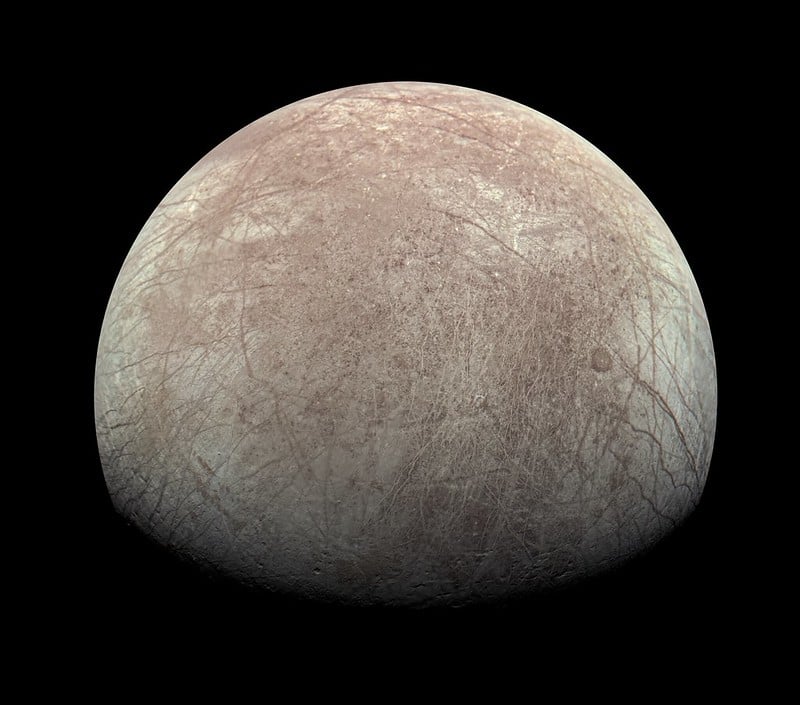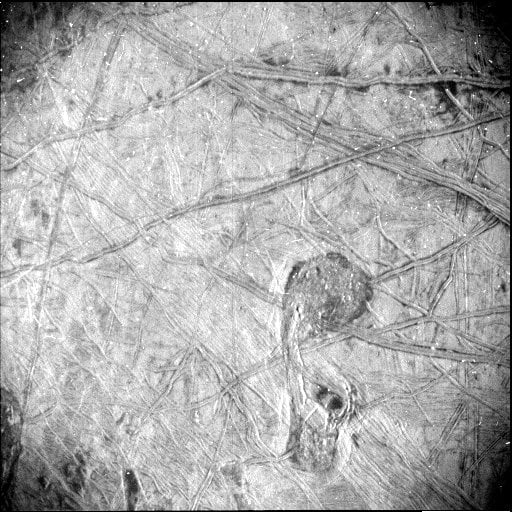It's been over twenty-two years since we've been able to see Jupiter's enticing moon Europa close-up. But now the Juno spacecraft has made its closest pass of Europa, sending back some amazing pictures of the icy mini-world, which likely has an ocean that contains more water than all of Earth's oceans combined.
Observations from the spacecraft's 45thorbit around Jupiter brought it close enough to give us some of the best views of Europa that we've ever had.
The Galileo mission was the last spacecraft that flew past Europa during its 8-year mission, which started in 1995. Galileo flew past Europa at 350 km (218 miles) away in 2000.
Most of the images here were taken by JunoCam, the outstanding public outreach camera, and images here have been downloaded and processed by members of the public who have been actively processing Juno's images since it reached Jupiter in 2016. The images here are by Kevin M. Gill, as well some below by with additional editing by Navaneeth Krishnan and AkaSci on Twitter.
However, NASA says this image, above, is the highest-resolution photo that Juno has ever taken of a specific portion of Europa's surface and it was taken by another camera, the Stellar Reference Unit (SRU), a star camera used to orient the spacecraft.
It obtained the black-and-white image during the spacecraft's flyby of Europa on Sept. 29, 2022, at a distance of about 412 km (256 miles). It reveals a detailed view of a puzzling region of the moon's heavily fractured icy outer crust.
The image covers about 150 kilometers (93 miles) by 200 km (125 miles) of Europa's surface, revealing a region crisscrossed with a network of fine grooves and double ridges (pairs of long parallel lines indicating elevated features in the ice).
Near the upper right of the image, as well as just to the right and below center, are dark stains possibly linked to something from below erupting onto the surface, possibly a collapse in the ice shell.
The SRU has a resolution that ranges from 256 to 340 meters (840 to 1,115 feet) per pixel, and the image was captured as Juno raced past at about 24 km per second (15 miles per second) over a part of the surface that was in nighttime, dimly lit by "Jupiter shine" – sunlight reflecting off Jupiter's cloud tops.
"This image is unlocking an incredible level of detail in a region not previously imaged at such resolution and under such revealing illumination conditions," said Heidi Becker, the lead co-investigator for the SRU. "The team's use of a star-tracker camera for science is a great example of Juno's groundbreaking capabilities. These features are so intriguing. Understanding how they formed – and how they connect to Europa's history – informs us about internal and external processes shaping the icy crust."
?s=20&t=-9_0aZ_QTls--1BUrfS8BQLoading tweet...
— View on Twitter
The SRU was designed for low-light conditions, and the team said it has also proven itself a valuable science tool, discovering shallow lightning in Jupiter's atmosphere, imaging Jupiter's enigmatic ring system, and now providing a glimpse of some of Europa's most fascinating geologic formations.
In addition to the images of Europa, all of the spacecraft's science instruments were collecting data both during the Europa flyby and then again as Juno flew over Jupiter's poles just 7 ½ hours later.
Loading tweet...
— View on Twitter
"Juno started out completely focused on Jupiter. The team is really excited that during our extended mission, we expanded our investigation to include three of the four Galilean satellites and Jupiter's rings," said Juno Principal Investigator Scott Bolton. "With this flyby of Europa, Juno has now seen close-ups of two of the most interesting moons of Jupiter, and their ice shell crusts look very different from each other. In 2023, Io, the most volcanic body in the solar system, will join the club."
Further reading/viewing:
Kevin Gill's Flickr page
JPL Press release
More information about the Juno Mission at NASA and SWRI
JunoCam
 Universe Today
Universe Today


